

Carbon Footprint research. Sustainability Indexes - Index Values. Contact printen DJSI Index Familiy The historical index values of the Dow Jones Sustainability Indices are available to download here: DJSI World USD Currency (Excel File) Euro Currency (Excel File)

Dow Jones Sustainability Index. The Dow Jones Sustainability Indexes (DJSI) launched in 1999, are a family of indexes evaluating the sustainability performance of the largest 2,500 companies listed on the Dow Jones Global Total Stock Market Index.

They are the longest-running global sustainability benchmarks worldwide and have become the key reference point in sustainability investing for investors and companies alike.[1] In 2012, S&P Indices and Dow Jones Indexes merged to form S&P Dow Jones Indices.[2] The DJSI is now managed cooperatively by S&P Dow Jones Indices and RobecoSAM (Sustainable Asset Management). The DJSI is based on an analysis of corporate economic, environmental and social performance, assessing issues such as corporate governance, risk management, branding, climate change mitigation, supply chain standards and labor practices. The trend is to reject companies that do not operate in a sustainable and ethical manner. History[edit] Atmospheric carbon dioxide. Carbon capture and storage. Schematic showing both terrestrial and geological sequestration of carbon dioxide emissions from a coal-fired plant An integrated pilot-scale CCS power plant was to begin operating in September 2008 in the eastern German power plant Schwarze Pumpe run by utility Vattenfall, in the hope of answering questions about technological feasibility and economic efficiency.

CCS applied to a modern conventional power plant could reduce CO2 emissions to the atmosphere by approximately 80–90% compared to a plant without CCS.[4] The IPCC estimates that the economic potential of CCS could be between 10% and 55% of the total carbon mitigation effort until year 2100.[4] Storage of the CO2 is envisaged either in deep geological formations, or in the form of mineral carbonates. Deep ocean storage is no longer considered feasible because it greatly increases the problem of ocean acidification.[6] Geological formations are currently considered the most promising sequestration sites.